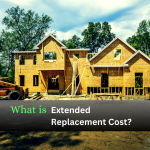Here is a summary of some of the most common homeowners insurance coverages along with our minimum coverage recommendations. Below the summary you’ll find definitions and explanations of each coverage so you can better understand when they might apply. We hope this homeowners insurance coverage guide helps you better understand your policy.
Summary
Dwelling: We recommend the amount determined by the carriers’ replacement cost estimate.
Other Structures: $10,000
Personal Property: 50% of Coverage A and Replacement Cost. You don’t want Actual Cash Value (ACV).
Loss of Use: 12 months. Usually built into the policy.
Personal Liability: $300,000
Medical Payments: $5,000
Additional Living Expenses: This is typically built into the policy and offers 12 months of expenses with no dollar amount limit.
Loss Assessment: Typically, only needed for condos or homes where the homeowners association has a master insurance policy and is responsible for the exterior of the structure.
Sewer and Water Back Up: $5,000. Consider significantly more for a finished basement.
Earthquake: Case by case basis
Service Line: Include
Extended Replacement Cost: Choose a minimum of 25%
Building Ordinance or Law Coverage: Typically built in at around 10% of Coverage A
Matching Undamaged Siding, Roofing, Windows: Case by case basis
Personal Offense: Include
Equipment Breakdown: Case by case
Refrigerated Products: Case by case
Coverage Detail
Dwelling (Coverage A)
Often referred to as “Coverage A”, this covers damage to home and attached structures, such as a porch. Replacement cost is different than market value. It’s very common for people to compare the market value of their home to their insurance coverage. Market value is what someone is willing to pay for your home. Replacement cost is the cost of rebuilding the home. For insurance purposes, we are only concerned with the cost to rebuild the home, not the market value.
Our minimum recommendation: Don’t go lower than the calculated replacement cost
Other Structures (Coverage B)
Covers stand-alone structures on your property, such as a fence or shed. Many times people don’t believe they need this coverage however it’s common that at some point in the future they put in a fence or shed and forget to let their agent know. This coverage is very cheap to add to the policy and therefore it’s safer to add it to the policy from the start.
Our minimum recommendation: $10,000
Personal Property (Coverage C)
Pays to repair or replace belongings that are stolen or damaged in a covered event. You can select Actual Cash Value (ACV) or Replacement Cost. We never choose Actual Cash Value b/c depreciation would not allow enough coverage to replace your items.
Our minimum recommendation: 50% of Coverage A and Replacement Cost. Do not choose Actual Cash Value (ACV).
Loss of Use
Provides coverage for increased expenses when a home is uninhabitable following a covered loss.
Our minimum recommendation: 12 months. Usually built into the policy.
Personal Liability (Coverage E)
Pays if you are legally liable for injuring someone or causing property damage unintentionally or through neglect.
Our minimum recommendation: $300,000
Medical Expense (Coverage F)
Pays to treat someone injured on your property, regardless of who’s at fault. Also, pays if you, a family member or a pet injures someone elsewhere. This does not cover injuries to household members, only guests.
Our minimum recommendation: $5,000
Pro tip: For smaller claims, Medical Payments offers the advantage of avoiding a lawsuit and lengthy claims process that typically accompanies a Personal Liability claim. Especially if it’s a family member or friend, it’s much easier to quickly close the claim for Medical Payments. In contrast, for Personal Liability they would need to file suit against you and make the case you were legally liable for their damages. Thanksgiving dinner is going to be awkward this year.
Additional Living Expenses (Coverage D)
Helps pay temporary living expenses while your home is being repaired.
Our minimum recommendation: This is typically built into the policy and offers 12 months of expenses with no dollar amount limit.
Loss Assessment
Covers assessments charged to the you by your homeowners association.
Our minimum recommendation: $10,000. Typically, only needed for condos or homes where the homeowners association has a master insurance policy and is responsible for the exterior of the structure.
Example: A hailstorm damages the roof of the home. In the homeowner association by-laws it states that the homeowners shall incur an assessment for roof repair costs. The total cost of the roof could be $7,000 and the insured is assessed $1,000.
Sewer and Water Back-Up
Provides coverage when a loss occurs caused by water which backs up through, or overflows from, a sewer, drain, sump, sump pump, or any system used to remove subsurface water from the foundation area. This coverage does not apply if the loss is flood induced.
You always want to include this coverage. Even if the basement is not finished there could be damage to heating and cooling, stored personal property and the cost of cleanup and possible remediation.
Our minimum recommendation: $5,000. Consider significantly more for a finished basement.
Earthquake
Covers damage to the home caused by earthquake. Has a deductible separate than the All Perils and Wind/Hail deductibles. Typically, the deductible is around 15-20%. This means 15-20% of Coverage A.
Example:
Coverage A (Dwelling): $300,000
Earthquake Deductible: 20%
300,000 * .20 = $60,000
The dollar amount of the deductible is $60,000.
Our minimum recommendation: Case by case basis
Service Line
Service lines are systems that provide basic services such as electricity, water, sewer and gas to a home. Your service lines run from your home out to the main lines which are usually located near the street.
Our minimum recommendation: $10,000
Extended Replacement Cost
Also sometimes referred to as Extended Dwelling Coverage. Your policy covers damages to your home up to a certain limit. This coverage ensures that if rebuilding costs exceed this limit you have a cushion that can prevent you from being underinsured. Inflation and market conditions are reasons why this can happen.
Our minimum recommendation: 25% Extended Replacement Cost
Building Ordinance or Law Coverage
Coverage for requirements to comply with any ordinance or law that regulates the construction, repair or demolition of dwelling following a covered loss.
Our minimum recommendation: Typically built in at around 10% of Coverage A
Matching Undamaged Siding, Roofing, Windows
Covers the replacement of undamaged siding, roof surfacing materials and/or windows to match the siding, roof surfacing materials and/or windows of a repaired area due to the replacement materials being unavailable or obsolete, or when the replacement materials do not match due to fading, weathering, oxidizing, texture or dimensional difference. This coverage does not apply unless the damage is caused by a covered peril.
May not be offered by all carriers.
Our minimum recommendation: Case by case basis
Personal Offense
Provides liability coverage for injury arising out of personal offenses, including but not limited to, false arrest, detention, libel, slander or defamation of character and invasion of privacy.
Most people never think they’ll be sued for libel or slander and yet a simple post on a social network or a blog that harms another person’s reputation could lead to a lawsuit costing thousands of dollars in legal fees and damages.
Our minimum recommendation: Include
Equipment Breakdown
Provides coverage for accidental direct physical loss to covered property caused by equipment breakdown. Wear and tear is excluded. Covered losses must be direct, accidental and sudden, such as a broken part or electrical arcing.
Our minimum recommendation: Case by case
Refrigerated Products
Provides coverage for loss to covered property stored in freezers/refrigerators.
Our minimum recommendation: Case by case






